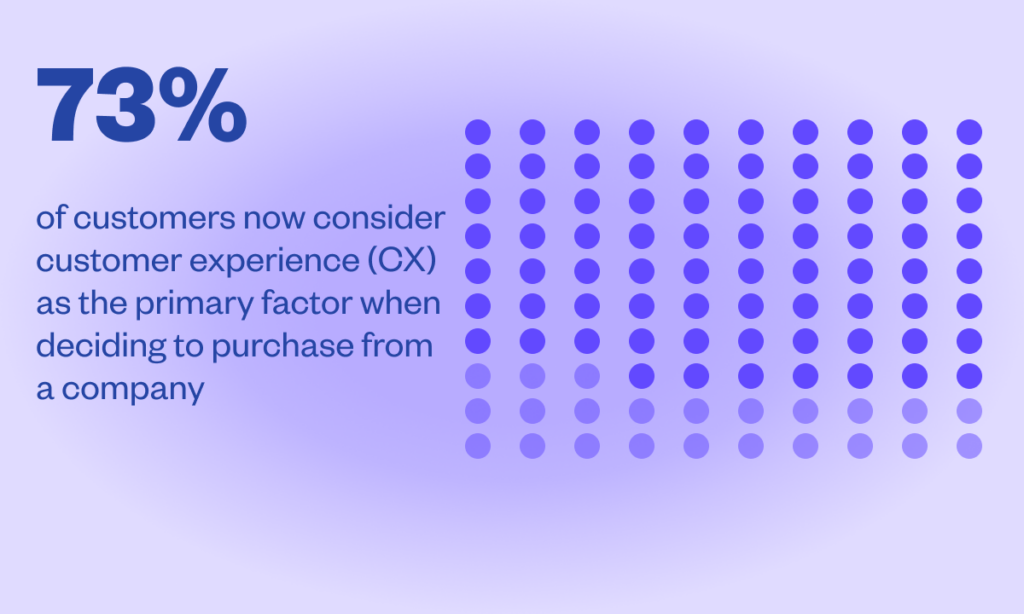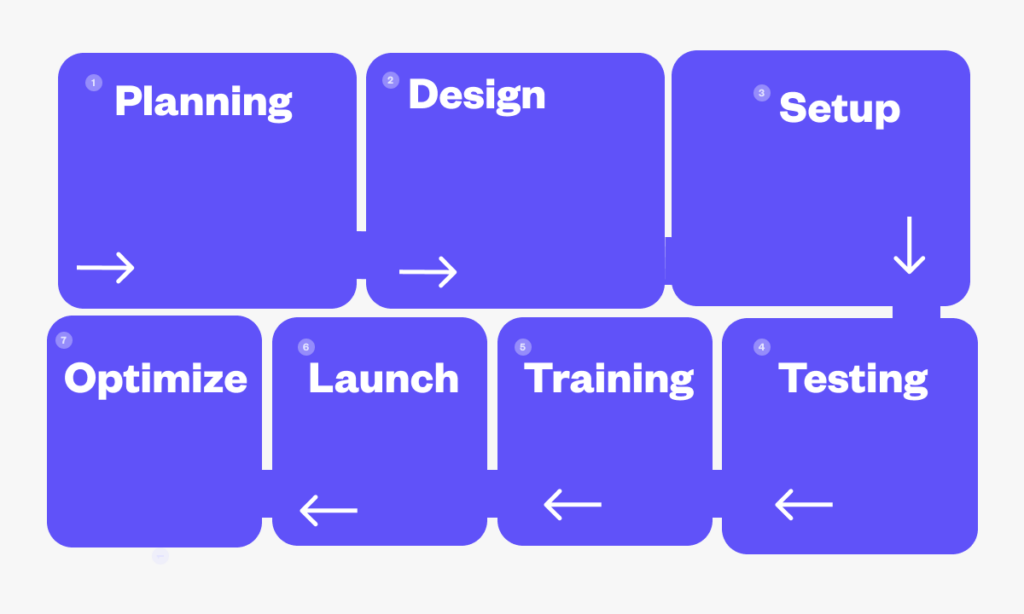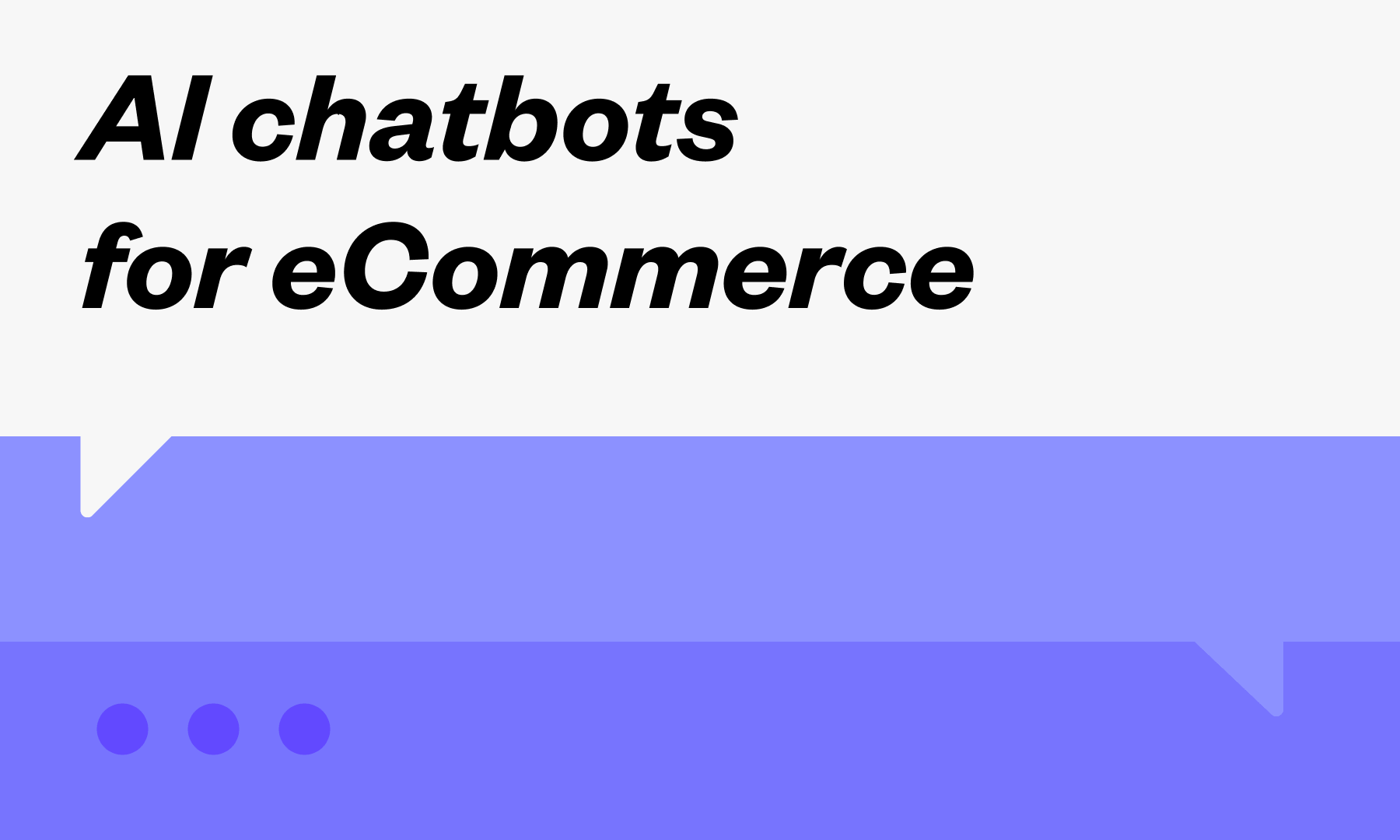With the advent of advanced AI technologies like OpenAI’s ChatGPT, many AI chatbots can now autonomously and accurately handle customer queries, transforming the way businesses operate.
But…
Not all are built for eCommerce, and not all have the capabilities to truly talk to your website visitors and customers in ways that resolve issues without human agent involvement.
This guide will explore the critical aspects of AI chatbots and their benefits, including how they drive higher conversion rates and enhance customer satisfaction. You’ll learn best practices for implementing them, managing risks, and measuring success. Additionally, we provide an evaluation checklist to select the best chatbot for your needs and strategies for seamless AI chatbot integration in your eCommerce business.
Download Full Guide for Free:
AI Chatbots for eCommerce 2024
So, let’s get started with some key terms:
The difference between chat, chatbots, AI chatbots, and virtual agents
In the ever-evolving world of customer service, the lines between various technologies like chat, chatbots, AI chatbots, and virtual agents can blur. Let’s clarify the distinctions:
- Live Chat: This technology enables real-time conversations between customers and sales/support agents, primarily supporting pre-sales queries.
- Chatbots: Rule-based systems that can respond to specific predefined commands or questions, often used to handle routine customer inquiries like FAQs.
- AI Chatbots: More advanced than traditional chatbots, they leverage natural language processing (NLP) to understand and generate human-like responses, personalize interactions, and handle complex queries.
- AI Virtual Agents: Integrated into the broader eCommerce stack, these virtual assistants (often powered by ChatGPT) excel in natural language understanding, providing seamless experiences across multiple platforms and ensuring up-to-date information regardless of the interaction point.
As AI capabilities accelerate and systems become more interoperable, AI virtual agents are powering many next-generation chatbots and customer service experiences.
The business case for chatbots
Implementing chatbots (AI or otherwise) can yield significant benefits for eCommerce businesses, including:
- Enhanced Sales: Over 50% of businesses using chatbots report generating higher-value baskets, with consumer spending via chatbots in retail predicted to reach $142 billion by 2024.
- Reduced Cart Abandonment: Chatbots can decrease cart abandonment rates, which can be as high as 69%, by providing real-time support and guidance.
- Cost Efficiency: Chatbots have allowed businesses to save approximately 2.5 billion hours of work in 2023 alone, with companies saving up to 30% on customer support expenses by automating routine interactions.
- Improved Customer Experience: 73% of customers now consider customer experience (CX) the primary factor when deciding to purchase from a company. Chatbots enhance CX by providing immediate responses to inquiries.
- Personalized Customer Engagement: AI-driven chatbots improve engagement through personalized recommendations and interactions, enhancing satisfaction by catering to individual preferences.

Pre-sale capabilities and higher conversion rates
You can expect 60-80% of chatbot engagements on your eCommerce website to relate to planned purchases, making chatbots a powerful tool for increasing conversion rates and average order values.
Top queries we see customers asking
AI chatbots can handle a wide range of pre-sale conversations, ensuring customers have the information they need to make purchasing decisions, including:
- Product Recommendations: Helping customers decide on the best product for their needs and narrowing down choices.
- Product Specifications: Educating customers about product features and capabilities, and comparing different products.
- Shipping Information: Providing details on shipping options, costs, and delivery times to help customers choose the best shipping method.
- Return Policies: Explaining the terms of the return policy, including the timeframe for acceptable returns, any costs involved, and the steps to initiate a return.
- Product Availability: Checking inventory in real-time and confirming availability or estimated restock dates.
- Price Inquiries: Informing customers about pricing, ongoing sales, or discounts to help them take advantage of cost-saving opportunities.
- Payment Options: Explaining available payment methods and financing options, including how to apply for installment plans if available.
Post-sale capabilities and higher customer satisfaction
20-40% of engagements with website chatbots can be post-sale queries from previous purchasers. Ensuring your AI chatbot can troubleshoot and handle these types of inquiries will take the heat off your support team and help improve customer satisfaction whilst driving down support team costs. These queries typically include:
- Order and Delivery Queries: Solving inquiries about order status, delivery timings, and logistics by providing live updates on shipment and estimated delivery times.
- Installation Assistance: Offering step-by-step instructions for setting up new products or addressing installation issues.
- Warranty and Repairs: Handling post-sale product issues by explaining the process to file a warranty claim, including how to schedule a service or send the item for repairs.
- Return Processing: Guiding customers through the return process, from packing the product to printing return labels and drop-off locations.
- Product Troubleshooting: Assisting with troubleshooting malfunctioning products by providing a checklist of common issues to resolve the problem.
- Payment or Subscription Management: Explaining the process and helping customers update their subscription settings.
- Feedback and Reviews: Facilitating the collection of customer feedback and reviews, directing customers to the appropriate page or collecting the feedback directly.
Evaluation checklist for choosing the best AI chatbot for eCommerce customer service
When selecting an AI chatbot for your eCommerce site look for seamless integration, comprehensive data access, and the ability to maintain a consistent brand voice, which makes them ideal for eCommerce businesses. A more detailed evaluation should consider these key feature sets:
Technical Capabilities:
- Advanced interoperability with eCommerce platforms, shipping software, and customer service tools
- Sophisticated machine learning and natural language processing (NLP)
- Scalability to handle increased interaction volumes
- Multimodal support for AI conversations, chatbot flows, live chat escalation, and service desk tickets
- Multilingual capabilities
User Experience:
- User-centric design for an intuitive customer experience
- Customizable brand tone of voice across multiple platforms and languages
- Consistent performance and user experience across all digital touchpoints
Business and Compliance:
- Advanced analytics on user interactions, system performance, and operational impact
- Data security and compliance with international regulations like GDPR
- Vendor support, including onboarding and dependable technical assistance
- Transparent pricing and demonstrated ROI through enhanced efficiencies and engagement
While there are many chatbot solutions on the market, one that stands out for eCommerce businesses is eDesk’s Ava AI Virtual Agent. Built specifically for eCommerce, Ava seamlessly integrates with major web store and marketplace platforms, enabling merchants to achieve happier customers wherever they sell.

Getting ready for a successful launch
A user-friendly Flow Builder provides an intuitive interface for designing custom processes, ensuring a smooth and effective launch tailored to your specific operational needs.
Implementing an AI chatbot is a multi-step process that requires careful planning and execution. Here’s how to prepare for a successful launch:
- Planning: Define clear objectives and requirements for the AI chatbot, such as what problems it needs to solve and what success looks like.
- Design: Design the chatbot’s workflow, including conversation paths, tone of voice, and reference materials.
- Setup: Integrate the chatbot with existing business systems like your eCommerce platforms and customer service solutions, including live chat tools.
- Testing: Perform extensive testing to ensure the chatbot functions as intended across various scenarios and in different contexts.
- Training: Train and continuously improve the AI chatbot’s learning through feedback loops, ensuring reference content and tone of voice are up-to-date. An eCommerce specific chatbot should be capable of having empathy and a customer service mindset.
- Launch: Deploy the chatbot in a live environment with real users, starting with a soft launch to monitor performance and gather initial feedback.
- Optimize: Continuously monitor the chatbot’s performance, identify issues or areas for improvement, and use analytics to track engagement.

Best practices for implementing an AI eCommerce chatbot
Utilize advanced analytics and continuous learning capabilities to optimize performance, personalize interactions, and ensure seamless escalation to human agents when necessary.
To achieve maximum outcomes with an AI chatbot in eCommerce, focus on management, optimization, and preparing your sales and support team:
- Comprehensive Training: Train your service and sales teams on how to use and leverage the AI chatbot effectively, including its capabilities, limitations, and how to seamlessly take over conversations as required.
- Regular Monitoring and Feedback: Implement a regular review and feedback loop for interactions handled by the chatbot. Use this feedback to identify any issues or areas for improvement in how the chatbot handles queries.
- Optimization Based on Analytics: Utilize the chatbot’s analytics tools to track performance metrics such as engagement rates, satisfaction scores, and conversion rates. Use insights from this data to refine the chatbot’s responses and interaction strategies.
- Integration with Sales Strategies: Integrate the chatbot into your broader sales and marketing strategies. Ensure it is equipped to support promotional campaigns, product launches, and can cross-sell or upsell effectively.
- Personalization Tactics: Leverage the chatbot’s ability to personalize interactions based on customer data. Customize communications to address customers by name and recommend products based on previous purchases.
- Ensuring Seamless Escalation: Establish clear protocols for when and how the chatbot should escalate complex issues to human agents. Ensure these transitions are smooth, and customers don’t have to repeat information.
- Continuous Learning and Improvement: Set up mechanisms for the chatbot to learn from each interaction—either through manual updates from observed interactions or automated learning capabilities based on well-defined guardrails.
Key metrics to measure success
Monitor engagement rates, resolution rates, and customer satisfaction scores to gauge success and make data-driven improvements.
To assess and drive the performance of your AI chatbot, track these key metrics:
- Customer Engagement Rate: Measures the frequency and duration of interactions customers have with the chatbot.
- Conversion Rates: Tracks the percentage of chatbot interactions that result in a sale or desired action.
- Customer Satisfaction (CSAT): Captures customers’ satisfaction with their chatbot interactions, typically through post-interaction surveys.
- First Contact Resolution: Measures the proportion of customer inquiries resolved by the chatbot without needing redirection or escalation to human agents.
- Average Handling Time: Calculates the average time taken by the chatbot to handle an interaction or resolve an inquiry.
- Cost Savings: Compares the cost of chatbot operations to the cost of traditional customer service channels.
- Accuracy Rate: Measures the accuracy of the chatbot’s responses and actions, based on correct understanding and processing of user requests.
- User Retention Rate: Tracks the rate at which users return to use the chatbot for additional interactions.
Managing risks and mitigating potential negative outcomes
Ensure robust data security and compliance, continuously update learning algorithms, and provide reliable vendor support to manage and mitigate potential risks.
While beneficial in many aspects, AI chatbots also present certain risks that businesses need to manage carefully:
- Privacy and Data Security Risks: Work with your vendor to implement robust data encryption, secure APIs, and access controls. Ensure compliance with data protection regulations like GDPR by designing chatbots with privacy in mind.
- Accuracy and Reliability Issues: Continuously train the chatbot with a wide range of scenarios to improve its learning algorithms. Regularly review and update the training data to reflect changes in customer behavior and feedback, and make sure that on some level it can handle angry customers.
- Emotional Intelligence Limitations: Design chatbots to recognize the limits of their capabilities and hand off to human agents when emotional intelligence is required. Train chatbots to detect sentiment and adjust responses accordingly.
- Inappropriate Responses: Ensure guardrails are adequate to prevent inappropriate conversations. Implement quality assurance processes to ensure chatbot responses align with brand values and communication standards.
- Scalability Challenges: Choose scalable chatbot platforms that can grow with your business. Plan for regular reviews and updates to handle increased demand and more sophisticated queries.
- Integration Complexities: Plan integration carefully, involving IT and customer service teams. Choose chatbot solutions that offer flexibility and compatibility with existing systems. Conduct thorough testing before full deployment.
- Overreliance on Technology: Maintain a balanced approach by having human agents available. Ensure chatbots complement human services, not replace them entirely.
The risk of not implementing an AI chatbot, however, may be even greater. As eCommerce AI trends accelerate and customer expectations evolve, businesses that fail to adopt conversational AI risk falling behind their competitors.
Cost considerations
Smaller businesses may see chatbot costs as part of their eCommerce website costs, whilst larger businesses with dedicated customer support functions will factor costs in with help desk solution costs, support team costs, etc.
When it comes to the specific cost of running an AI chatbot, pricing can vary significantly depending on the vendor, features, and scale of implementation. Some solutions charge per conversation or user, while others offer flat monthly or annual fees.
eDesk’s ROI calculator can help you estimate the potential cost savings and return on investment of implementing their AI virtual agent solution. Generally, chatbots can generate significant cost savings by automating routine interactions and reducing the workload on human agents.
To find the right balance between cost and capabilities, it’s essential to evaluate your business needs and projected growth, then select a scalable solution that can adapt as your requirements change.
Closing thoughts
As eCommerce continues to evolve, AI chatbots are becoming an indispensable tool for enhancing the customer experience, driving sales, and improving operational efficiencies. By leveraging natural language processing, machine learning, and seamless integration with existing systems, AI virtual agents like eDesk’s Ava are transforming the way eCommerce businesses interact with their customers.
While implementing an AI chatbot requires careful planning, training, and risk mitigation, the potential rewards are significant. By following best practices, measuring key metrics, and continuously optimizing your chatbot’s performance, you can unlock new levels of customer satisfaction, conversion rates, and cost savings.
Ava: the best AI chatbot for eCommerce?
We believe a combination of AI efficiency and human empathy is the key to driving eCommerce growth, and Ava is our first step towards this future.
If you’ve read this far then there’s a good chance you’re trying to find the best AI chatbot for eCommerce. As part of that journey, we would like to invite you to explore and learn more about Ava to see how it can transform your customer service operations.
We believe it’s the best AI chatbot for eCommerce but only you can decide!


